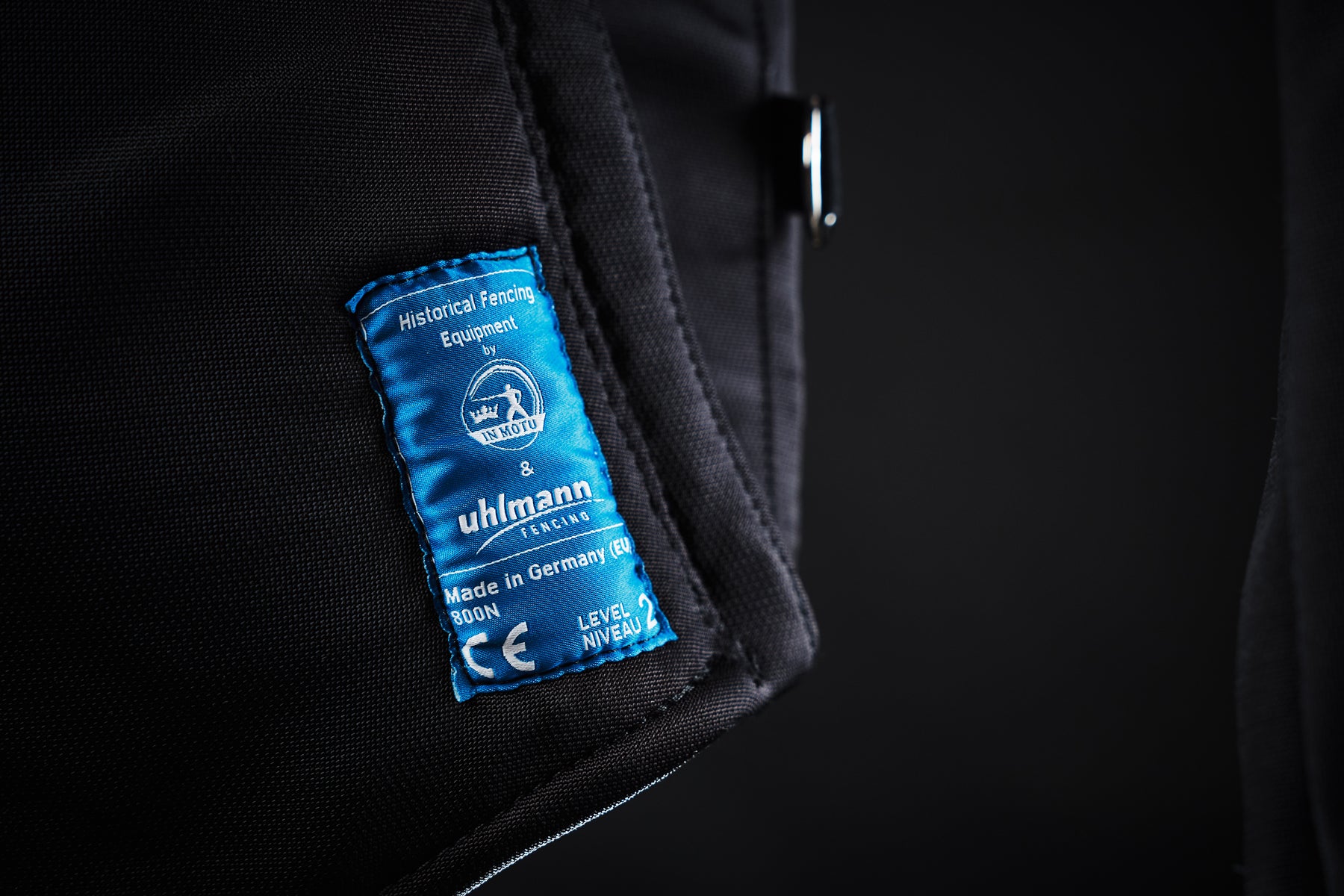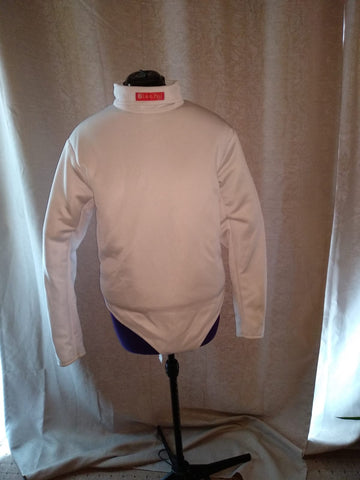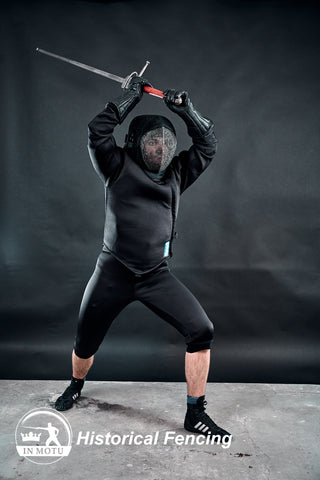
CE in historical fencing? The development of the St. George fencing suit
Why CE? The development of the St. George fencing suit
How it started
When I received the fortunate information a few weeks ago that the St. George fencing suit had received the declaration of conformity, a huge weight fell off my heart. Finally it was done! But what was actually accomplished and why did I even start on this path?
I have been practicing sword fighting and historical fencing since I was 13 years old, so for almost 21 years. When I started teaching in 2007, I didn't know that after more than 13 years as an officer I would become a fencing instructor. Preparations began in 2014 to turn the IN MOTU club into a fencing school. Of course, all legal conditions also had to be clarified and planned. But at the time, it wasn't clear to me what additional legal implications for protective equipment would arise after the school was founded.
I also adapted my curriculum to gear planning. This means that as fencing develops, so does the equipment. Of course, this also meant deciding which equipment I would recommend to my students. After the new multi-year curriculum reached a point where the first ones had to gradually acquire protective equipment for combat, I intensified this planning and fortunately had a lot of expert support. As a trainer, it is of course my obligation to recommend material and equipment that will not cause any health or legal disadvantages to my students. It became increasingly apparent that the area of protective equipment was and is very explosive in many respects. On the one hand, because accidents can of course happen in fencing and you adapt your guidelines and rules of conduct accordingly. But accidents can always happen, even with good internal rules on behavior. And if accidents happen, you have insurance.
What I only realized during this time was that the insurance company can of course ask what equipment was worn during the accident. If this does not comply with applicable regulations, it may result in an insurance company not paying out. But as a coach, principal, tournament organizer, and someone who also wanted to encourage his students to purchase equipment on-site at their own school, that meant I had to delve deeper into the topic. I started doing this in 2018, when the transition to becoming a full-time fencing instructor was getting closer and closer. That’s when the topic of “personal protective equipment” and “CE” came up. Fortunately, in the European Union the end consumer of goods is very well protected. CE is not only a symbol of tested safety for electrical appliances or glass panes. Personal protective equipment must also comply with applicable regulations (I will create a separate blog post about these regulations). Protective equipment in sports also falls under this regulation, as you can see from the equipment on the market in other sports such as rugby, football, ice hockey, karate, etc.
So from 2018 onwards I increasingly looked for equipment that complied with these regulations and would protect my students as consumers in every way. I was disappointed to discover that they simply didn't exist. I could not recommend HEMA equipment to my students because it was never tested, certified and labeled according to current regulations. Only the pieces of equipment already used in Olympic fencing met the requirements. Except for the fencing mask and the corresponding protective hood, these were only suitable for a few areas of historical fencing.
Unfortunately, even when we asked some HEMA manufacturers, nothing happened. The students who asked about the safety and certification of the jackets they had already purchased were put off several times and still have no answer today. So I had to find a way to provide my students with equipment that complied with the applicable regulations and thus enabled them to fence safely and also did not cause me as a coach any legal problems or remorse.
The decision
So in 2018 I finally decided to initially approach the manufacturers of Olympic fencing in the area of fencing suits. The Leon Paul company in England made the first jacket prototypes for me in 2019. Some fencers were able to test these prototypes at the meeting of historical fencers from Central Germany in Borchen in 2019. With Brexit, I left this path and was even more pleased to be able to win Uhlmann, a German manufacturer that is one of the largest in the world and has many years of experience in producing the best fencing equipment.


I had long since collected the problems with well-known jackets and trousers that I knew from my many years of experience and incorporated the ideas of other fencing colleagues. During this time, I worked on a lot of materials to combine high mobility, low weight and sufficient protection at an optimal level.
With a precise idea in mind, I had a seamstress from Nordhausen make my first prototype with the desired materials and was excited about the result. This result was fantastic for me at the time!
When the prototype was ready, I immediately drove to my fencing hall with my equipment and tried it on. It was light, highly mobile and could absorb blows and stabs to my liking. It no longer had anything in common with the previous prototypes that had been tested in Borchen. Here you can find a video of the prototype in question.
This made the concept of the upcoming fencing jacket and trousers clear. I presented this prototype to my new cooperation partner Uhlmann, who was also convinced of my project. So we looked at how we could implement my jacket idea with the matching pants, of course. We manufactured three more prototypes and improved them throughout 2020. Here you can see a video of the first black prototype with the corresponding fencing trousers.
We didn't let Corona discourage us. According to the current regulations, I had the prototypes tested and evaluated by various fencing colleagues from all over Germany. One of them was my fencing friend Michael Sprenger from Dresden, whose review you can read here . We continued to improve what was possible. Ultimately, a fencing suit was created that we were completely satisfied with. This was also evident when I was able to present and test the jacket prototypes and the corresponding new leather vest at the Tremonia Fencing School in autumn 2020.
The fencers were very enthusiastic, as you can see from some of the posts here in the blog. (Review by Christian Lee-Becker , Review by Lukas Maestle-Goer )
Women's model
In spring 2020, female fencers asked me if I would also design a women's model. Of course, Uhlmann and I also thought about the women, because that was also on my list of improvements. In conversations over the past few years, I have been told several times that the current fencing jackets often cause problems for women. Therefore, we used Uhlmann's experience with Olympic cuts for women's jackets and tested a women's model with a student at my school. We were very happy with that too.

(Discount in the picture is no longer current)
The name St. George
During the entire development, I traveled to Uhlmann in Laupheim several times to ensure smooth processes and good communication. I like to talk to friends on the phone on my long journeys. On this trip I spoke on the phone again with my student and friend Patrick and we thought about what names the fencing equipment could be given - what would have a strong connection to fencing? One thing has been typical of fencing since the Middle Ages: the reference to “patron saints”. The typical saint for fencers and knights was Saint George. So we took Saint George as the patron saint of fencers and knights, as often mentioned in the old fencing manuscripts. I was finally able to convince my fencing colleague Dierk Hagedorn to provide us with his motif of Saint George. So it became his motif that we use for the fencing jacket and its name for recognition.

Certification
The lengthy certification process began in the summer of 2020. After we found the final form, we immediately started it in a German institute. From Uhlmann's experience it was clear that such a process takes a lot of time.
But what does certification actually mean? Personal protective equipment must be tested in the EU in accordance with current regulations [1]. There are three categories of protective equipment that are described. Category I names areas that are associated with a low risk of injury. This equipment can be tested and labeled by the manufacturer itself. Category III names areas with a very high risk for the wearer. The effort here is very large and requires many lengthy processes, as you can see in the graphic here.

All areas of use of protective equipment that are not explicitly mentioned in the document are automatically included in Category II. This also includes fencing or historical fencing. In this category II, the protective equipment must be tested by an institute in accordance with the requirements of the EU regulations and in accordance with the protection requirements aimed at by the manufacturer. So here the material is not simply tested for its stab resistance, but there is a long list of requirements that must be checked and achieved. Here are just a few examples:
- Certification and monitored product testing of protective clothing: EU type testing of PPE (CE marking) and monitored product testing in accordance with Regulation (EU) 2016/425, Annex
- Product and usability tests
- Acceptance analyzes and quality monitoring
- Durability of the products (e.g. how many washes the jackets last)
- Checking clothing sizes
- Testing of preliminary products for personal protective equipment
- Testing the construction and functional parameters of textile fabrics
- Checking and assessing the design for fulfillment of the protective function (i.e. whether the product actually achieves the specified protective effect)

It was therefore clear that we could not have tests based solely on the existing standards from Olympic fencing, but that these would be used as a comparison for the test procedures. It was therefore clear that our fencing suit belongs to Category II of PPE, i.e. it has to go through the long test process described above in an institute, and should reach Level II in the fencing standard.
The testing center, which is itself certified according to EU specifications and therefore has the specialist staff to evaluate the products in every respect, has tested and certified our fencing suits according to these and many other specifications. To do this, we had to send a lot of suits as prototypes (around 30 jackets and trousers) in different colors, men's sizes, women's sizes and children's sizes to the so-called prototype test, which of course can no longer be used afterwards. By the way, this entire process is correctly called conformity assessment. The effort and costs of such certification are immense. This would not have been possible without my cooperation partner Uhlmann.

By the way: every company and every dealer that sells, distributes or imports personal protective equipment in the EU that is not tested, certified and labeled in accordance with the requirements described in the EU for personal protective equipment is committing a criminal offense. It is not enough to simply use tested material. The end product must be declared compliant according to the regulations described above! For level 2 fencing jackets, this always means a type test and conformity assessment with a certificate from another institute.
As an end customer, you are not making yourself liable to prosecution in any way. But you may have the problem that you don't know what your equipment can actually do. And if it doesn't do what it's supposed to and doesn't protect you properly in the event of an accident, then you may have the problem described above that your insurance won't pay. Of course I didn't want that for my students and my events. I didn't want to embark on such a legally questionable path myself.
Done!
After more than seven months of testing, we finally did it! At the end of January 2021, the institute sent us the corresponding certificate. Our fencing jacket is probably the first to comply with the legal requirements of the EU. In doing so, I have achieved a goal and completed a project that I started more than two years ago.
I think the video shows that the end product is impressive! ;-)
You can see how long it takes to develop high-quality protective equipment in a legally compliant manner. But in the end you shouldn't forget one thing: all these regulations and complicated, lengthy procedures have only one goal:
To protect the consumer – i.e. you as a fencer.
It's worth it to me!
You can find out more about the St. George fencing suit here .

[1] Regulation (EU) 2016/425 of the European Parliament and of the Council of 9 March 2016 on personal protective equipment and repealing Directive 89/686/EEC

Leave a comment